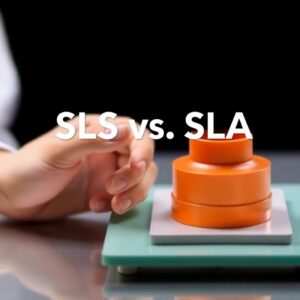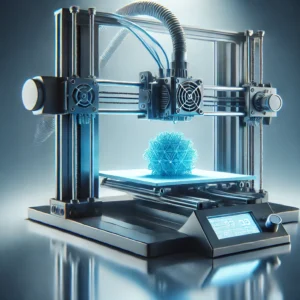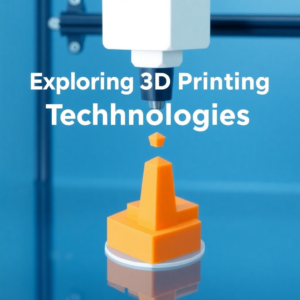SLS vs. SLA: Which Technology Fits Your Industry?

In the ever-evolving world of manufacturing, 3D printing has proven to be a game-changer. The ability to create intricate parts and prototypes quickly and cost-effectively has opened doors to innovation across multiple industries. Among the various 3D printing technologies available today, two stand out for their widespread use: Selective Laser Sintering (SLS) and Stereolithography (SLA). These technologies are transforming sectors ranging from aerospace to healthcare, offering unique advantages depending on the specific needs of the industry.
Choosing the right 3D printing technology for your business can be a challenge. Understanding the differences between SLS and SLA is crucial to making an informed decision. Both technologies serve different purposes, offering distinct advantages in material versatility, surface finish, speed, and durability. This article will compare the two, helping you determine which one fits your industry’s needs.
How SLS and SLA Work
Selective Laser Sintering (SLS)
SLS is an industrial 3D printing technology that uses a high-powered laser to sinter (fuse) powdered material into solid structures. The process begins with a layer of powder, typically made from materials such as nylon, polyamide, or metal powders. The laser traces the shape of the object layer by layer, fusing the powder together to form a solid structure. Once a layer is completed, another layer of powder is added, and the process repeats.
One of the key features of SLS is that it does not require any support structures. Since the surrounding powder acts as support during the build process, it is ideal for creating complex geometries and intricate parts. The materials used in SLS are typically durable, making the technology well-suited for functional prototypes, end-use parts, and even small production runs.
Stereolithography (SLA)
SLA is one of the oldest 3D printing technologies, known for its ability to produce high-precision models with excellent surface finishes. SLA uses a process where a laser is directed at a vat of liquid photopolymer resin, curing the resin layer by layer to build up a solid object. Unlike SLS, which uses powder, SLA relies on liquid resin, which is sensitive to ultraviolet (UV) light.
The SLA process is capable of producing very fine details and smooth surfaces, which makes it ideal for prototyping and manufacturing small parts that require high precision. Post-processing is often required to remove any excess resin and to cure the printed model fully, but the results are often of superior quality compared to other 3D printing technologies.
Key Differences Between SLS and SLA
Material Variety
-
SLS: One of the major advantages of SLS is the wide variety of materials it supports. From thermoplastics like nylon to glass-filled and even metal powders, SLS offers a diverse range of materials suitable for a variety of applications. The materials used in SLS tend to be durable, flexible, and strong, making it a popular choice for producing parts that need to endure stress or wear.
-
SLA: SLA primarily uses photopolymer resins, which can be engineered to achieve different properties such as flexibility, transparency, and high heat resistance. While the material options in SLA are more limited compared to SLS, resins continue to improve in terms of mechanical strength and other specialized properties. However, SLA materials are generally more brittle than SLS materials, which may not be ideal for parts that need to withstand significant stress or impact.
Surface Finish
-
SLS: While SLS is a powerful technology for producing durable parts, the surface finish can be rougher compared to SLA. The powdered material tends to leave a slightly textured surface, and parts often require post-processing to achieve a smoother finish. This is especially important for applications where aesthetics are critical.
-
SLA: SLA is known for its high-resolution and smooth surface finishes. Due to the layer-by-layer curing process, SLA prints have a fine texture with minimal visible layer lines, making them perfect for highly detailed models where surface smoothness is important. However, even with SLA, post-processing may be required to further smooth the surface or remove any remaining uncured resin.
Speed and Efficiency
-
SLS: SLS is generally faster when producing multiple parts in a single build. Since it’s possible to print several parts at once, SLS can be highly efficient for batch production. However, the speed of the build depends on the complexity of the parts and the printer’s specifications. Post-processing is often required to remove the parts from the powder bed and clean them.
-
SLA: SLA is typically slower, especially when printing large objects. The layer-by-layer curing process can take time, and since SLA focuses on high precision, it may not be as fast as SLS when producing multiple parts. However, for small, highly detailed prototypes or low-volume production, SLA offers a level of precision that makes up for its slower speed.
Durability and Strength
-
SLS: Parts produced with SLS are generally more durable and functional. The high-density materials used in SLS are robust enough for functional prototypes, small batch production, and end-use parts. For industries like aerospace, automotive, and healthcare, where durability is a priority, SLS offers a solid choice.
-
SLA: SLA parts are not as durable as SLS parts, but they are suitable for applications that require high detail over strength. While certain resins used in SLA can offer higher mechanical properties, SLA is better suited for creating prototypes, molds, or other parts where the focus is on precision and finish rather than strength.
Cost Considerations
-
SLS: SLS machines tend to be more expensive due to the complex nature of the technology. The need for high-powered lasers and advanced equipment means higher upfront costs. Additionally, the materials used in SLS can also be more expensive than SLA resins. However, for businesses requiring high-performance parts and functional prototypes, the investment in SLS can be worthwhile in the long run.
-
SLA: SLA machines are typically more affordable, and the resins used in SLA are generally less expensive than the powders used in SLS. This makes SLA an attractive option for businesses or individuals looking for high-precision prototypes on a budget. However, when considering the cost of post-processing and resin types, prices can vary.
Industry Applications of SLS and SLA
Aerospace
-
SLS: In the aerospace industry, lightweight and durable parts are critical. SLS is widely used for creating functional components such as brackets, housings, and interior parts for aircraft. The ability to create complex geometries without the need for support structures makes SLS ideal for aerospace applications that demand strength and low weight.
-
SLA: SLA is used in the aerospace industry for creating high-precision prototypes and models. The technology is particularly useful for detailed interior parts, design validation, and producing intricate parts for aircraft models.
Automotive
-
SLS: Automotive manufacturers use SLS to create durable prototypes, testing parts, and even production parts. Its ability to print strong, functional parts makes it suitable for applications like engine components, structural parts, and lightweight prototype models.
-
SLA: Automotive designers use SLA to create highly detailed interior components, conceptual models, and prototypes for aesthetic validation. SLA is excellent for producing small parts that require high resolution and finish.
Healthcare
-
SLS: SLS is used in healthcare for producing custom prosthetics, implants, and surgical tools. Its durability and ability to handle complex geometries make it an excellent choice for creating functional medical devices and orthotics.
-
SLA: SLA is heavily used in dental applications for creating dental models, crowns, and bridges. Its precision allows for the creation of highly detailed dental parts, and it is also used in producing surgical guides and anatomical models for pre-operative planning.
Consumer Goods
-
SLS: SLS technology is used to produce durable consumer goods such as wearables, electronics components, and small production runs of custom items. The strength and versatility of SLS materials make it ideal for producing high-performance, customized products.
-
SLA: In the consumer goods sector, SLA is used to create prototypes, models, and detailed parts that require high precision. Products such as personalized accessories and small-run items benefit from SLA’s precision and smooth finishes.
Fashion and Jewelry
-
SLS: SLS is gaining popularity in the fashion industry for creating durable, customizable accessories and components. It is especially useful for creating lightweight, intricate designs in wearable fashion items like shoes or accessories.
-
SLA: SLA is widely used in jewelry manufacturing for creating intricate designs with fine details and smooth surfaces. The high-resolution capabilities of SLA are perfect for producing delicate pieces like rings, bracelets, and other custom jewelry items.
Prototyping
-
SLS: SLS excels in creating functional prototypes that can be tested for real-world application. Industries that need to test parts under stress, such as aerospace or automotive, benefit from SLS’s durability and material versatility.
-
SLA: SLA is ideal for producing prototypes that require high precision, fine details, and smooth surfaces. It is often used in industries like consumer electronics, where the prototype’s appearance and functionality need to be validated early in the design process.
Choosing Between SLS and SLA: Which One is Right for Your Industry?
Factors to Consider
-
Budget: Consider your available budget for both the initial investment and operational costs. If you are looking for a cost-effective solution with fine details and high precision, SLA may be the better option. For industries that require more durable and functional parts, SLS may justify its higher cost.
-
Desired End Product: Think about what the final product needs to accomplish. If you need strong, functional parts, especially for industrial applications, SLS is the better choice. For high-precision prototypes or parts requiring intricate details, SLA is ideal.
-
Production Volume: SLS is better suited for larger production volumes, as it allows multiple parts to be produced in a single build. SLA is more suitable for low-volume production or rapid prototyping, where high precision is the primary concern.
-
Turnaround Time: SLA tends to be slower in terms of build time for larger parts, while SLS is better for creating multiple parts in one go. If you need faster production, SLS may be a better fit for your needs.
Both SLS and SLA technologies offer unique advantages, and the decision between the two ultimately depends on your industry’s specific needs. If you require durability, strength, and the ability to produce functional parts, SLS is the better choice. However, if you need high precision, fine surface finishes, and the ability to produce detailed prototypes, SLA may be your preferred technology.
Understanding the key differences and applications of SLS and SLA will help you make the right choice for your business. As technology continues to advance, both SLS and SLA are expected to evolve, offering even more exciting possibilities for manufacturers across industries.
Visit our other website: https://synergypublish.com





